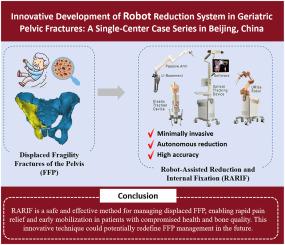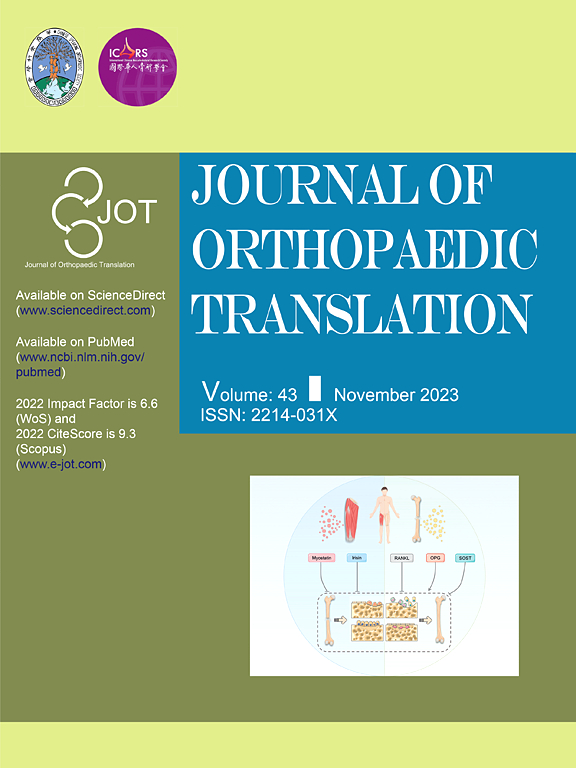Innovative development of robot reduction system in geriatric pelvic fractures: A single-center case series in Beijing, China
IF 5.9
1区 医学
Q1 ORTHOPEDICS
引用次数: 0
Abstract
Displaced fragility fractures of the pelvis (FFP) pose significant challenges in orthopaedic trauma, owing to patient comorbidities, deteriorating bone quality, and surgical complexities. Despite technological advancements, no robotic methods have been documented for displaced FFP management. To address this, we introduced an advanced robot-assisted fracture reduction system, comprising a tracking device, path planning software, and robotic arms. This study evaluated fifteen consecutive patients with displaced FFP (average age 80.4 ± 9.1 years), who underwent robot-assisted reduction and internal fixation (RARIF) between January 2022 and May 2023. All were categorized as Rommens FFP type III, with a median time of 6 days (range 4–11) from injury to surgery. Operative times averaged 165 ± 44 min, with median blood loss of 50 mL. Postoperative radiographs showed all patients achieved excellent or good reductions as per Matta criteria, marking a 100 % success rate. A 6-month follow-up revealed an average modified Majeed score of 81.4, with 85.7 % of patients rated excellent or good. All fractures healed without complications. Leveraging our intelligent system, RARIF proves to be a safe and effective approach for displaced FFP, facilitating postoperative pain alleviation and early mobilization despite compromised health and bone conditions. This approach may revolutionize the management of FFP in an increasingly aging population, signaling a significant shift in therapeutic strategies.
Translational Potential of this Article: Elderly patients with displaced FFP often present complex surgical challenges due to comorbidities and poor bone quality, complicating reduction procedures and often leading to ineffective fixation. Addressing these challenges, we have developed an innovative robot-assisted fracture reduction system, offering a practical alternative to conventional methods. This system optimizes the applied force and direction during the reduction process, thereby reducing the needs for manual and repetitive attempts. Our report, detailing the successful implementation of this technique in 15 FFP cases, signifies a considerable leap forward in the field of orthopaedic surgery. This technique notably benefits the elderly population, a group traditionally marginalized in receiving care for complex orthopedic conditions.

老年骨盆骨折机器人复位系统的创新发展:中国北京单中心病例系列
骨盆移位性脆性骨折(FFP)给创伤骨科带来了巨大挑战,这是因为患者合并症多、骨质不断恶化以及手术复杂。尽管技术在不断进步,但目前还没有用于治疗骨盆移位性骨折的机器人方法。为此,我们引进了先进的机器人辅助骨折复位系统,该系统由跟踪装置、路径规划软件和机械臂组成。本研究对 2022 年 1 月至 2023 年 5 月间接受机器人辅助骨折复位和内固定术(RARIF)的 15 名移位 FFP 患者(平均年龄为 80.4 ± 9.1 岁)进行了评估。所有患者均被归为罗门氏 FFP III 型,从受伤到手术的中位时间为 6 天(4-11 天不等)。手术时间平均为 165 ± 44 分钟,中位失血量为 50 毫升。术后X光片显示,根据Matta标准,所有患者都达到了极佳或良好的缩小效果,成功率为100%。6 个月的随访显示,改良的 Majeed 评分平均为 81.4 分,85.7% 的患者被评为优或良。所有骨折均愈合,无并发症。利用我们的智能系统,RARIF 被证明是治疗移位的 FFP 的一种安全有效的方法,尽管患者的健康状况和骨骼条件受到损害,但它仍能减轻术后疼痛并促进早期活动。这种方法可能会彻底改变对日益老龄化的人群中 FFP 的管理,标志着治疗策略的重大转变:由于合并症和骨质差,移位的FFP老年患者往往面临复杂的手术挑战,使还原手术复杂化,往往导致固定效果不佳。为了应对这些挑战,我们开发了一种创新的机器人辅助骨折复位系统,为传统方法提供了一种实用的替代方案。该系统能优化骨折复位过程中的作用力和方向,从而减少人工操作和重复尝试的需要。我们的报告详细介绍了这项技术在 15 例 FFP 病例中的成功应用,标志着骨科手术领域的重大飞跃。这项技术明显惠及老年人群,而这一群体在接受复杂骨科疾病治疗时历来被边缘化。
本文章由计算机程序翻译,如有差异,请以英文原文为准。
求助全文
约1分钟内获得全文
求助全文
来源期刊

Journal of Orthopaedic Translation
Medicine-Orthopedics and Sports Medicine
CiteScore
11.80
自引率
13.60%
发文量
91
审稿时长
29 days
期刊介绍:
The Journal of Orthopaedic Translation (JOT) is the official peer-reviewed, open access journal of the Chinese Speaking Orthopaedic Society (CSOS) and the International Chinese Musculoskeletal Research Society (ICMRS). It is published quarterly, in January, April, July and October, by Elsevier.
 求助内容:
求助内容: 应助结果提醒方式:
应助结果提醒方式:


